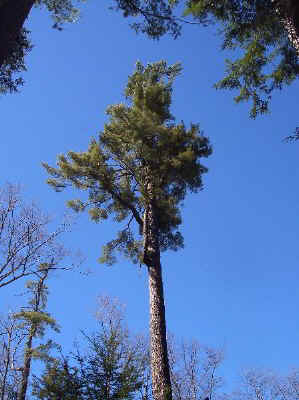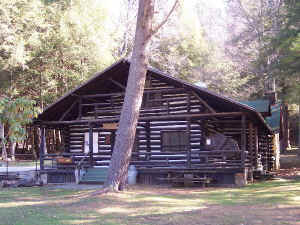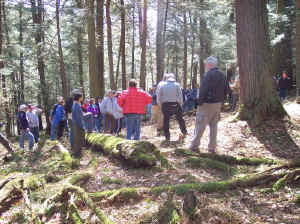| Cook
Forest Big Tree Event / ENTS Rendezvous 2007 |
April 20-21, 2007 |
| |

Heart's Content Pine - photo by
Carl Harting
| Back
to Don: Useful Formula List |
dbhg-@comcast.net |
|
Apr
23, 2007 08:30 PDT |
Don,
At the dendromorphometry presentation on
Saturday AM, I think I saw a few folks in the audience throwing
up the sign of the cross at me at each new formula. Made me a
little nervous. I think I was supposed to return to my coffin
and close the lid tight. Joking aside, the presentation went
well. I'll soon know. Lee sat up front and I think was grading
me. He hasn't sent me my grade yet. I'm hoping for at least a
B+.

Log Cabin Inn- Photo by Carl Harting
Dr. William Carr, developer of the RD
1000 Dendrometer-Relascope attended the presentation and event.
He's a great guy. We got along very well. ENTS couldn't have a
better connection to LaserTech. This fellow is heavy duty. Too
bad Paul Jost, our resident electrical engineer, wasn't there to
ask questions and understand the answers.
Later on Saturday, Will climbed
the Seneca hemlock and did a successful tape drop. From up the
ridge, I took two measurements of the tree via our ENTS methods.
I got 144.8 feet on one shot and 145.8 on the other. The average
of those two, which I felt were equally probably is 145.3 feet.
Will's tape drop was 145.4 feet. Results like those allow me to
feel very confident that overall, our sine-based technique is
not only good, but very good. The big tree yields about 750
cubic feet of trunk volume. That is most respectible.
On our return trip, Monica and I went
through Loyalsock State Forest and I got to see a swath of
tuiptrees that follows the Loyalsock River. The Loyalsock is in
the northeastern quadrant of PA, east, but not extreme east -
maybe just east of center. Overall the trees are slender, I
measured one roadside tuliptree to 13.1 feet in circumference
and 140.2 feet in height. It was the largest tulip I saw. I
think several others are in the 130 to 140-foot height class. I
hope Monica and I can return to the Loyalsock maybe later this
summer. It is worth getting a full Rucker index on. The
ridge-side stuff is nothing to get excited about, but the ravine
trees have potential.
Bob
|
| 10
going to 11 and beyond |
Robert
Leverett |
| Apr
23, 2007 10:13 PDT |
ENTS,
The just concluded
Cook Forest Extravaganza enters the annals of
ENTS as another successful gathering of the faithful, with a few
curious
onlookers wondering what all the fuss was about. It is always
good to
gather together, talk shop, and share experiences with my Ent
comrades,
but this gathering had a bonus for me. Dr. William Carr, the
designer of
the Criterion 400 (I think), the RD 1000 (I'm sure), and other
forest
measuring devices joined us. Bill is a splendid fellow and
possesses a
wealth of knowledge. He and I have communicated a number of
times before
on both the RD 1000 Dendrometer-Relascope and the Trupulse 200
Laser
Rangefinder-Hypsometer. But it was a surprise and pleasure to
meet Bill
in person. He is a fountain of knowledge and insights. Why did
he come,
considering that he has a blistering schedule and doesn't live
close by?
He is from Montana and he travels all over the world. Be that as
it may,
he still came to the ENTS gathering at Cook Forest and honored
us by his
presence.
 RD 1000 Dendrometer-Relascope
RD 1000 Dendrometer-Relascope
Well, I think Bill realizes
that ENTS is a highly competent,
dedicated group that merits observing. We will find new uses for
some of
his instruments and exercise them in exotic ways. We will put
numbers
into the books that have scientific value and his instruments
will have
made contributions. He got a handout on dendromorphometry, which
documents the extreme forms of our pre-occupation. Well, he
ain't seen
nuthin, yet. The genie is out of the bottle. Exploring the
features of
trees in the field mathematically and discovering dimensional
attributes
that may be obvious only in hindsight is where we are headed.
The
challenge is to bring our whole group along. The ENTS motto
should be:
Leave no Ent Measurer Behind".
Bob
Robert T. Leverett
Cofounder, Eastern Native Tree Society
|
| Re:
Cook Forest Big Tree Event |
Lee
Frelich |
| Apr
23, 2007 17:24 PDT |
Bob:
I just got back home from Cook Forest.
It hard to decide whether you should get a B+ or an A- for you
presentation
at Cook Forest, but I am sure that the final document on
dendromorphometry,
whenever it is finished, will be an A+.
On the way home I didn't have time to stop at Warren Woods, but
I did stop
at Carver Roehl County Park, in Rock County, WI (where I grew
up), to see
the stand of yellow oak (Q. Muhlenbergii), which I hadn't seen
since I
moved to MN 20 years ago. It hasn't changed at all. This stand
is right on
the northern edge of the range, and the trees must be very slow
growing.
I still can't figure why it was 70 degrees and sunny during the
Cook Forest
Bog Tree Extravaganza--where was the usual rain/snow mixture
accompanied by
30 mph winds? Thanks to Dale for arranging the good weather and
the schedule.
Lee
|
| RE:
Cook Forest Big Tree Event |
Carl
Harting |
| Apr
23, 2007 19:06 PDT |

It was refreshing to see the parking lot nearly full at the Log
Cabin
Inn Saturday morning. I don't think the weather could have been
any
better with clear skies, comfortable temperatures and no wind or
bugs to
speak of. What a great experience. Will's tree climb definitely
generated some interest as several folks approached us with
questions in
only a short period of time.
Scott,
Good lord that sycamore is awesome!! Wish I could have been
there with
you to see it.
The butternut height was 59.9 feet.
Carl
|
| Cook
Forest Rendezvous... |
E.
Daniel Ayres |
| Apr
25, 2007 16:38 PDT |
ENTS:
Thanks to everyone who helped make this event happen. It
is so gratifying
to see first hand that there are people who share the interest
and
excitement I feel when I look at a big tree. Dale's
trigonometry lesson
gets an A+ from me because of his careful attention to both
sources and
magnitudes of errors. I doubt if I personally will every own and
use any of
the expensive measurement equipment, preferring to take pictures
and call in
the experts if I find anything significant in my travels. My
high school
geometry and trigonometry teacher once again was remembered for
her awesome
"extra credit" week of lectures on estimation
delivered to a room full of
seniors feeling the heat and waiting for graduation.

I took a trip down memory lane and revisited the Ridge Camp
campsite I
inhabited in the summers of 1950, and 1951. Three
familiar trees near
campsite #18 were still there, surprisingly to me, not that much
bigger 56
years later, but almost everything else is changed. The old
handmade stone
fireplaces are gone, There were no big wooden tent platforms,
the deeply
shaded and thickly treed, needle carpeted flat where I met my
first deer has
been gutted to make room for buildings, dug up to bring in
electricity for
RV's, and filled with gravel to support vehicles. Everywhere
around the
circle things seem worn and tired. The duff
seems thinner, and in many
places has been worn away by human traffic. There were stumps
everywhere
bringing to mind trees that died or were removed to open things
up, and only
traces of the old circle road remain. Its
pavement was uneven and broken
up in places those many years ago, but I recognized a trace of
the original
pavement near the end of the entrance road going up before the
first dip.
Hopefully the rain we are getting here will bring needed
additional moisture
in as it moves east.
During the Saturday afternoon tree climb, as I was making my
contributions
to the disturbance of mosses and helping trample the area around
the tree
being climbed, I asked myself, "How long will the area
around the site take
to recover from our visit?" Anyone
comment? Cook Forest seemed so big
back then. Now it is tiny.
E. Daniel Ayres, AKA ZundapMan
|
|